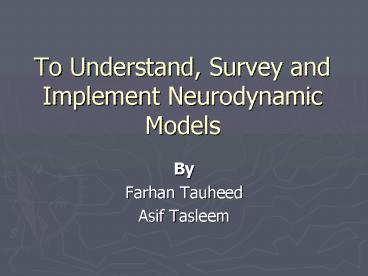To Understand, Survey and Implement Neurodynamic Models - PowerPoint PPT Presentation
1 / 9
Title:
To Understand, Survey and Implement Neurodynamic Models
Description:
Any uniform fading memory mapped behind a static network can simulate just as well ... Speech Recognition (phoneme recognition) Multimedia Compression ... – PowerPoint PPT presentation
Number of Views:70
Avg rating:3.0/5.0
Title: To Understand, Survey and Implement Neurodynamic Models
1
To Understand, Survey and Implement Neurodynamic
Models
- By
- Farhan Tauheed
- Asif Tasleem
2
Project Progress
- Literature Review
- Temporal Networks
- Specific Problem for Implementation
- Implications
- Architectural Plan for Implementation
- Formal definition
3
Motivation
- Machine Perception
- Biological aspects of Traditional Neural Network
Models - Summation neuron
- Non Linear Activation function
- Non biological aspects
- Static
- Continuous Input
- Back propagation learning algorithm
4
Temporal Neural Networks
- Biologically Inspired
- Continuous data feed is operated on
- Dynamic Model
- Long term Memory
- Short term Memory
- Tapped delay line
- Distributed Time Lagged Feed forward NNs
- Different Back Propagation algorithm
5
Literature Review
- Universal Myopic Mapping theorem
- Any uniform fading memory mapped behind a static
network can simulate just as well - Fontine and Shastri 1993. have demostrated that
certain tasks not having an explicit temporal
aspect can also be processed advantageously by
Temporal Networks - Thompson(1996) Completeness of BSS
6
Related Problems
- Time Series Data Prediction
- Blind Signal Separation
- Cocktail Party Problem
- Attention Based Search Optimization
- Visual Pattern Recognition
7
Blind Signal Separation Implication
- Speech Recognition (phoneme recognition)
- Multimedia Compression
- MM database sound based retrieval
- Noise Removal
- Audio Analysis and Visualization
- Sonar and Radar
- Cache Hit Algorithms
8
Architectural Plan
- Formal Problem Description
- xis input.
- each xi is a mixture of a number of
constituent signals ujs - we need to separated out/ deconvolute the ujs
from xis. - Frequency Domain
- Multilayered Network
- Hebbian Learning rule
9
To work on
- Neurodynamics theorems
- Stability issues
- Oscillatory / Pulsating Neural Networks
- THE END

